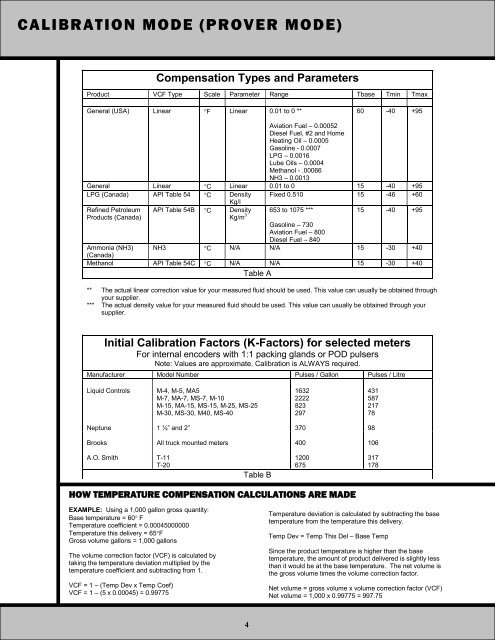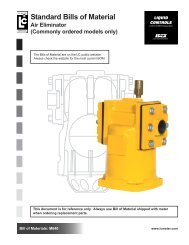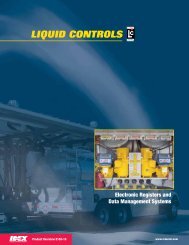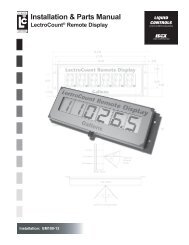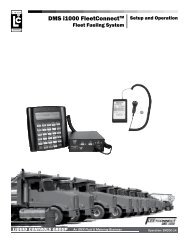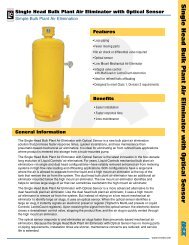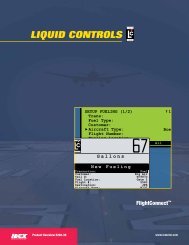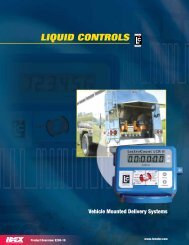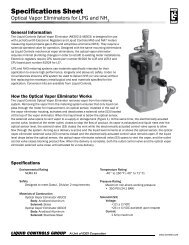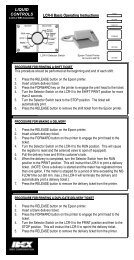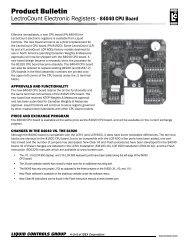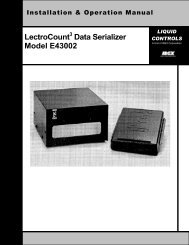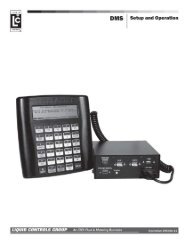LectroCount3 Calibration Procedures Addendum - Liquid Controls
LectroCount3 Calibration Procedures Addendum - Liquid Controls
LectroCount3 Calibration Procedures Addendum - Liquid Controls
Create successful ePaper yourself
Turn your PDF publications into a flip-book with our unique Google optimized e-Paper software.
CALIBRATION MODE (PROVER MODE)<br />
Compensation Types and Parameters<br />
Product VCF Type Scale Parameter Range Tbase Tmin Tmax<br />
General (USA) Linear °F Linear 0.01 to 0 **<br />
60 -40 +95<br />
Aviation Fuel – 0.00052<br />
Diesel Fuel, #2 and Home<br />
Heating Oil – 0.0005<br />
Gasoline - 0.0007<br />
LPG – 0.0016<br />
Lube Oils – 0.0004<br />
Methanol - .00066<br />
NH3 – 0.0013<br />
General Linear °C Linear 0.01 to 0 15 -40 +95<br />
LPG (Canada) API Table 54 °C Density Fixed 0.510 15 -46 +60<br />
Kg/l<br />
Refined Petroleum<br />
Products (Canada)<br />
API Table 54B °C Density<br />
Kg/m 3 653 to 1075 ***<br />
Gasoline – 730<br />
Aviation Fuel – 800<br />
Diesel Fuel – 840<br />
15 -40 +95<br />
Ammonia (NH3) NH3 °C N/A N/A 15 -30 +40<br />
(Canada)<br />
Methanol API Table 54C °C N/A N/A 15 -30 +40<br />
Table A<br />
** The actual linear correction value for your measured fluid should be used. This value can usually be obtained through<br />
your supplier.<br />
*** The actual density value for your measured fluid should be used. This value can usually be obtained through your<br />
supplier.<br />
Initial <strong>Calibration</strong> Factors (K-Factors) for selected meters<br />
For internal encoders with 1:1 packing glands or POD pulsers<br />
Note: Values are approximate. <strong>Calibration</strong> is ALWAYS required.<br />
Manufacturer Model Number Pulses / Gallon Pulses / Litre<br />
<strong>Liquid</strong> <strong>Controls</strong> M-4, M-5, MA5 1632 431<br />
M-7, MA-7, MS-7, M-10 2222 587<br />
M-15, MA-15, MS-15, M-25, MS-25 823 217<br />
M-30, MS-30, M40, MS-40 297 78<br />
Neptune 1 ½” and 2” 370 98<br />
Brooks All truck mounted meters 400 106<br />
A.O. Smith T-11 1200 317<br />
T-20 675 178<br />
Table B<br />
HOW TEMPERATURE COMPENSATION CALCULATIONS ARE MADE<br />
EXAMPLE: Using a 1,000 gallon gross quantity:<br />
Base temperature = 60° F<br />
Temperature coefficient = 0.00045000000<br />
Temperature this delivery = 65°F<br />
Gross volume gallons = 1,000 gallons<br />
The volume correction factor (VCF) is calculated by<br />
taking the temperature deviation multiplied by the<br />
temperature coefficient and subtracting from 1.<br />
VCF = 1 – (Temp Dev x Temp Coef)<br />
VCF = 1 – (5 x 0.00045) = 0.99775<br />
Temperature deviation is calculated by subtracting the base<br />
temperature from the temperature this delivery.<br />
Temp Dev = Temp This Del – Base Temp<br />
Since the product temperature is higher than the base<br />
temperature, the amount of product delivered is slightly less<br />
than it would be at the base temperature. The net volume is<br />
the gross volume times the volume correction factor.<br />
Net volume = gross volume x volume correction factor (VCF)<br />
Net volume = 1,000 x 0.99775 = 997.75<br />
4


